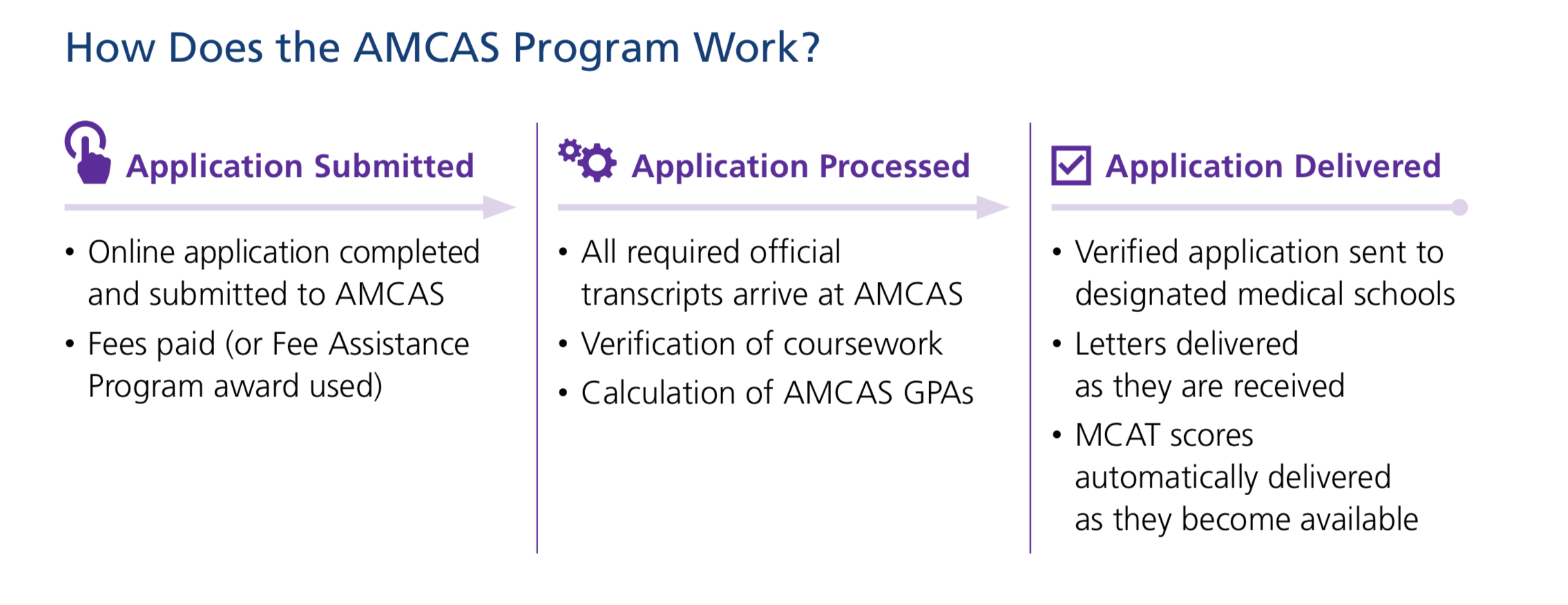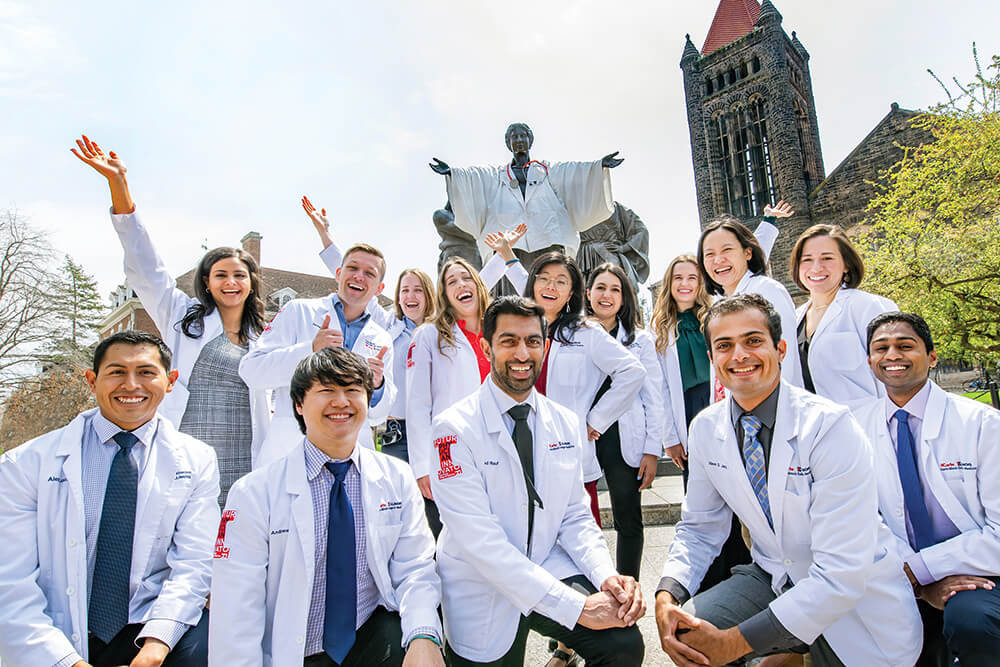What Is The AMCAS?
The American Medical College Application Service (AMCAS) is a centralized, online application used by first-year applicants to medical schools in the United States. AMCAS simplifies the process by allowing you to apply to multiple medical schools with just one set of application materials, reducing the need to send separate documents to each school.
When To Submit AMCAS
Each medical school sets its own AMCAS deadline, so check the specific school’s website for details. For the 2025 cycle, AMCAS opens on May 1, 2024, with submissions starting May 30, 2024. Deadlines vary by school, typically ranging from October 1, 2024, to December 1, 2024, all due by 11:59 p.m. Eastern Time (ET).
We recommend submitting your primary application as early as possible to take advantage of rolling admissions.
Your AMCAS application can be submitted before AMCAS receives your letters of evaluation, but official transcripts are required for verification to begin. Check if you’re eligible for the AAMC Fee Assistance Program (FAP) before applying. For 2025, FAP reduces the AMCAS application fee from $175 for the first school to $138, and additional schools from $45 to $37 each. You must wait for an FAP decision before submitting to receive these benefits. Learn more about FAP eligibility and benefits here.
What Things Does The AMCAS Application Include?
Organize your materials well in advance to ensure a smooth application process. Here’s what you’ll need to include:
Identifying Information
Provide basic details like your name, date of birth, and sex.
Provide basic details like your name, date of birth, and sex.
Schools Attended
List all post-secondary schools attended, even if you didn’t earn credit or withdrew before completing a degree.
List all post-secondary schools attended, even if you didn’t earn credit or withdrew before completing a degree.
Transcripts
Submit transcripts from every post-secondary institution where you took at least one course, using the AMCAS Transcript Request Form. AMCAS prefers electronic transcripts via services like Parchment or the National Student Clearinghouse, though paper transcripts are accepted if sent directly from the institution.
Submit transcripts from every post-secondary institution where you took at least one course, using the AMCAS Transcript Request Form. AMCAS prefers electronic transcripts via services like Parchment or the National Student Clearinghouse, though paper transcripts are accepted if sent directly from the institution.
Biographic Information
Include your address, citizenship, legal residence, childhood background, and how you paid for college.
Include your address, citizenship, legal residence, childhood background, and how you paid for college.
Military Service
If you’ve served in the military, provide details, including active-duty status or discharge information.
If you’ve served in the military, provide details, including active-duty status or discharge information.
Criminal History
List any misdemeanors or felonies, but minor traffic violations (e.g., speeding tickets with fines under $250) are typically excluded unless specified by the school.
List any misdemeanors or felonies, but minor traffic violations (e.g., speeding tickets with fines under $250) are typically excluded unless specified by the school.
Coursework
List all academic work, including courses where you didn’t earn credits, overseas courses, and high school dual-credit courses. Have your official transcripts handy to avoid omissions or errors, which can delay your application.
List all academic work, including courses where you didn’t earn credits, overseas courses, and high school dual-credit courses. Have your official transcripts handy to avoid omissions or errors, which can delay your application.
Work and Activities
Highlight significant work, extracurriculars, awards, honors, and relevant experiences. You can list up to 15 activities, with 700 characters (including spaces and punctuation) per entry. For up to three ‘most meaningful’ activities, you get an additional 1,325 characters each to elaborate. Choose experiences that reflect your passion for medicine.
Highlight significant work, extracurriculars, awards, honors, and relevant experiences. You can list up to 15 activities, with 700 characters (including spaces and punctuation) per entry. For up to three ‘most meaningful’ activities, you get an additional 1,325 characters each to elaborate. Choose experiences that reflect your passion for medicine.
Letters of Evaluation
Indicate who will write your letters (up to 10), specifying submission methods like AMCAS Letter Service or Interfolio. Letters should highlight your strengths and suitability for medical school.
Indicate who will write your letters (up to 10), specifying submission methods like AMCAS Letter Service or Interfolio. Letters should highlight your strengths and suitability for medical school.
Medical Schools
List the medical schools you’re applying to. Research each school’s admission requirements and mission statement to ensure they’re a good fit for your goals.
List the medical schools you’re applying to. Research each school’s admission requirements and mission statement to ensure they’re a good fit for your goals.
Personal Statement
Submit a personal essay to distinguish yourself from other applicants. Your essay, limited to 5,300 characters (including spaces and punctuation)—or 3,600 characters for MD-PhD programs—should be authentic and personal. Start drafting early to allow time for revisions.
Submit a personal essay to distinguish yourself from other applicants. Your essay, limited to 5,300 characters (including spaces and punctuation)—or 3,600 characters for MD-PhD programs—should be authentic and personal. Start drafting early to allow time for revisions.
Standardized Tests
List all MCAT exams taken, along with other standardized tests. MCAT scores are valid for three years—scores from 2022 or later are accepted for the 2025 cycle.
List all MCAT exams taken, along with other standardized tests. MCAT scores are valid for three years—scores from 2022 or later are accepted for the 2025 cycle.
Certification and Submission
Certify that all information is true and accurate before submitting.
Certify that all information is true and accurate before submitting.
What Happens After I Submit My Application?

After submitting your application and official transcripts, it enters the verification queue. Verification typically takes 2-4 weeks but can be faster if submitted early. Monitor your application status to ensure AMCAS receives your transcripts and other materials. Your ability to edit is limited post-submission—you cannot modify experiences, essays, or coursework, so proofread carefully before submitting.
Enhancing Your AMCAS Application in 2025
Navigating the AMCAS application process in 2025 requires not only meeting the basic requirements but also leveraging modern tools and strategies to stand out. Here’s how to enhance your application, from submission to interview preparation, ensuring you’re competitive in today’s landscape.
Start by understanding the 2025 AMCAS timeline and fees. Applications opened on May 1, 2024, with submissions starting May 30, 2024. Deadlines vary by school, typically ranging from October 1, 2024, to December 1, 2024, all due by 11:59 p.m. Eastern Time (ET). Check each school’s website for specifics. AMCAS charges $175 for the first school and $45 for each additional school, but the AAMC Fee Assistance Program (FAP) reduces this to $138 and $37, respectively, for eligible applicants. Apply for FAP before submitting to benefit from these savings. Verification now takes 2-4 weeks, faster if you submit early, so monitor your status to ensure transcripts are received—AMCAS prefers electronic submissions via Parchment or the National Student Clearinghouse.
When completing the application, accuracy is key. In the Coursework section, list all post-secondary courses, including overseas and high school dual-credit courses, using your transcripts to avoid errors that delay verification. The Work and Activities section allows up to 15 entries, with 700 characters (including spaces and punctuation) per entry, and an additional 1,325 characters for up to three ‘most meaningful’ activities. Highlight impactful experiences, like research or volunteering, that show your passion for medicine. The Personal Statement is your chance to shine—limited to 5,300 characters (or 3,600 for MD-PhD applicants), it should be authentic and revised multiple times. Use AI tools like Grammarly or ChatGPT to draft and refine your essay, ensuring clarity and coherence, but always personalize the final version to reflect your voice. For Letters of Evaluation, you can submit up to 10, specifying writers and submission methods (e.g., AMCAS Letter Service, Interfolio). Ensure letters highlight your strengths as a medical school candidate. In the Standardized Tests section, list all MCAT exams—scores from 2022 or later are valid for 2025.
Beyond the basics, modern strategies can elevate your application. Research schools thoroughly in the Medical Schools section, aligning their mission statements with your goals. For example, if a school emphasizes rural health, highlight relevant experiences in your application. Use online resources like the AAMC’s Medical School Admission Requirements (MSAR) database to compare your stats—average MCAT for matriculants in 2024 was 511.9, and GPA was 3.77—to target schools where you’re competitive. Social media platforms like X and Reddit (e.g., r/premed) offer insights from current applicants, helping you gauge trends and avoid common pitfalls.
Interviews in 2025 are often virtual, so prepare accordingly. Many schools use the Multiple Mini Interview (MMI) format, presenting ethical scenarios or teamwork challenges. Practice with platforms like Zoom to ensure technical readiness, and simulate interviews using tools like InterviewPrep, which offers AI-generated feedback on responses. Dress professionally, ensure a quiet environment, and test your internet connection. Traditional interviews may focus on your motivations—prepare answers to questions like “Why medicine?” by tying your experiences to your personal statement. Schools may also ask about current healthcare issues, such as telehealth’s role post-COVID, so stay informed via sources like the New England Journal of Medicine.
Finally, manage post-submission steps strategically. After verification, schools may send secondary applications—respond within two weeks, as most use rolling admissions. Pre-write secondaries using prompts from previous years, available on forums like Student Doctor Network. If waitlisted, send a letter of intent to your top choice, updating them on new achievements (e.g., publications, awards). AMCAS allows limited post-submission edits (e.g., adding new schools or letters), but coursework and essays are locked, so proofread carefully before submitting. By combining meticulous preparation with modern tools, you’ll maximize your chances of success in the 2025 AMCAS cycle.




